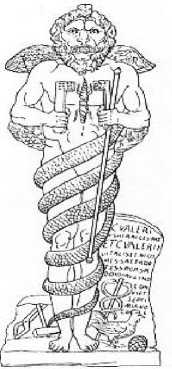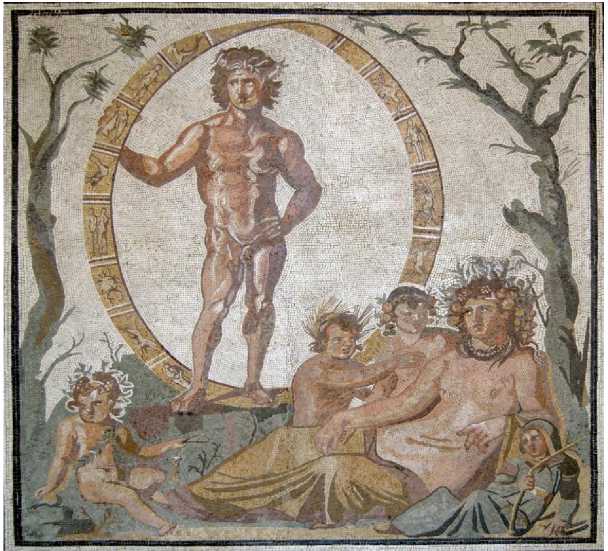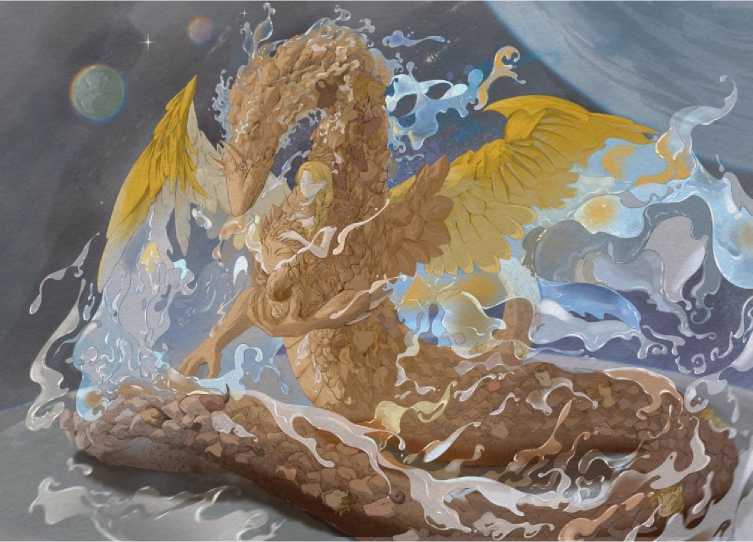Is lion-headed man orphic Chronos?
Автор: Song Ju.
Журнал: Schole. Философское антиковедение и классическая традиция @classics-nsu-schole
Рубрика: Статьи
Статья в выпуске: 1 т.18, 2024 года.
Бесплатный доступ
This paper discusses the identification of god figure depicted as a man with a lion's head, which has been associated with Aion and equated with Orphic god Chronos. The author challenges the equation of Aion with Orphic Chronos, drawing on evidence from Proclus and Damascius, who both distinguish Aion as a separate entity from Chronos. Additionally, the author presents an attempt to illustrate the Orphic god Chronos based on Damascius' description.
Chronos, aion, orphism, greek mythology, aion, damascius
Короткий адрес: https://sciup.org/147244493
IDR: 147244493 | DOI: 10.25205/1995-4328-2024-18-1-56-63
Текст научной статьи Is lion-headed man orphic Chronos?
However, the equation of Aion with Orphic Chronos is problematic. Neoplatonic philosophers have recognized the difference between Aion and Chronos: Damascius describes Aion as a Phoenician god4, while Chronos is an Orphic god:
Damascius. On First Principles . C-W II.210.8-11.
ὅθεν πηγὴν μὲν πηγῶν αὐτο (τὸ ἕν πολλά) Χαλδαίων παῖδες ἀνευϕημοῦσιν, Ὀρφεύς δε Μῆλτιν σπέρμα φέροντα θεῶν, Φοίνικες δὲ Αἰώνα κοσμικόν, ὡς πάντα ἐν ἑαυτῷ συνῃρηκότα.5
There is also a Chaldean god called Aion, mentioned by Proclus in his In Timaeum Commentaria III.14.3-10:
ἡ τάξις τοῦ αἰῶνος…Διὸ καὶ ὑπό τῶν λογίων “πατρογενὲς φάος” εἴρηται, διότι δὴ τὸ ἑνοποιὸν φῶς πᾶσιν ἐπιλάμπει, “πολὺ γὰρ μόνος ἐκ πατρὸς ἀλκῆς δρεψάμενος νόου ἄνθος ἔχει τὸ νοεῖν πατρικὸν νοῦν καὶ νόον ἐνδιδόναι πάσαις πηγαῖς τε καὶ ἀρχαῖς καὶ δινεῖν αἰεί τε μένειν ἀόκνῳ στροφάλιγγι."6
Proclus is also surely conscious of Chronos as an Orphic god elsewhere and thus differentiates Aion from Chronos in his works. In conclusion, though both Aion who is depicted as the lion-headed man and Chronos are gods of time, they are two distinguished gods; one is Phoenician god of time, and one is Orphic. The god-figure shown as a lion-headed man with snakes should be identified as Aion and there is no further evidence to identify it as Orphic Chronos.
So how can Orphic Chronos be identified? A famous portrait of this divinity appears in Damascius’ On First Principles , C-W III.161.3-8. Rather than a man, this portrait depicts an immense serpent with bull and lion heads and a human face that is positioned in the middle of the serpent. One should, then, distinguish such a Chronos from the god-figure represented as a lion-headed man:
On First Principles III.160.16-161.8.
Ἡ δὲ κατὰ τον Ἱερώνυμον ϕερομένη καὶ Ἑλλανικον, εἰπερ μὴ καὶ ὁ αὐτός ἐστιν, οὕτως ἔχει. Ὕδωρ ἦν, ϕησίν ἐξ ἀρχῆς καὶ ὑλη ἐξ ἦς ἐπάγη ἡ γῆ… [III.161.3] τρίτην ἀρχὴν μετά τὰς δύο γεννηθῆναι ἐκ τούτων, ὕδατός ϕημι καὶ γῆς, δράκοντα δὲ εἶναι καὶ κεϕαλὰς ἔχοντα προσπεϕυκυίας ταύρου καὶ λέοντος, ἐν μέσῳ δὲ θεοῦ πρόσοπων, ἔχειν δὲ καὶ ἐπὶ τῶν ὤμων πτερά, ὠνομάσθαι δὲ Χρόνον ἀγήραον καὶ Ἡρακλῆα τὸν αὐτον· συνεῖναι δὲ αὐτῷ τὴν Ἀνάγκην, ϕύσιν οὖσαν τὴν αὐτὴν καὶ Ἀδράστειαν.7
Athenagoras’ evidence from 300 years earlier than Damascius corroborates the opinion that the appearance of the Orphic Chronos should be a huge snake/dragon, not a man. His description of the Orphic Chronos’ appearance is the very same as Damascius’ at OFP III.161.3-8.
Athenagoras. Legatio .18.4.
Ἦν γὰρ ὕδωρ ἀρχὴ κατ´αὐτὸν τοῖς ὅλοις, ἀπὸ δὲ τοῦ ὕδατος ἰλὺς κατέστη, ἐκ δὲ ἑκατέρων ἐγεννήθη ζῷον δράκων προσπεφυκυῖαν ἔχων κεφαλὴν λέοντος , διὰ μέσου δὲ αὐτῶν θεοῦ πρόσωπον, ὄνομα Ἡρακλῆς καὶ Χρόνος. Οὗτος ὁ Ἡρακλῆς ἐγέννησεν ὑπερμέγεθες ᾠόν.8
His use of the same word for water (ὕδωρ), its role as the beginning of all things together with mud, and the description of Chronos saying he should be called Heracles indicate that he was familiar with the same theogony as Damascius, who attributed it to Hieronymus or Hellanicus—though whether he had read the work of Hieronymus and Hellanicus, as Damascius had, is unclear. Hence, this is an authentic corroboration of the serpentine appearance of Chronos.
Scholia in Gregorii Nazianzeni also briefly describes this figure of Orphic Time, though he does not directly refer to it as Chronos but as Heracles9 (Chronos’ alias, as Damascius mentioned):
Scholia in Gregorii Nazianzeni Or. 31 c. 16 (ed. Norden, Hermes 27, 1892, 614.) ὡς ἐξ ὕδατος καὶ ἰλύος ἀναδοθέντος δράκοντος προσπεφυκυῖαν ἔχοντος λέοντος κεφαλήν, διὰ μέσου δέ αὐτῶν θεοῦ πρόσωπον, ὅν Ήρακλήν φασι.10
There is another Aion figure that is depicted as a man standing in the Zodiac (Figure 2), but this figure is also clearly different from the Orphic Time Damascius and Athenagoras describe. In conclusion, I agree that the lion-headed man should be identified as Aion or a personification of time, as many scholars have shown, but this figure cannot be Orphic Time (Chronos).
There are, indeed, many similarities between the physical descriptions of the lion-headed man and Orphic Chronos: snakes; human, bull, and lion heads; and wings on the shoulders. Many scholars have demonstrated that these images may originate among Near Eastern deities with theriomorphic features and primordial Greek monsters. Both Guthrie and Bernabé compare the descriptions of Chronos with the four-headed, four-winged creatures described by the Hebrew prophet Ezekiel: The four faces of each of these supernatural beings were those of a man, a lion, an ox, and an eagle (Ezekiel 1: 6–13).11 Brisson compares the figure of Chronos with the Modena relief of Mithras.12 A famous Greek precedent is provided by the mythical Typhon depicted by Hesiod and Apollodorus, a monstrous sea serpent described as having a hundred snake heads projecting from his shoulders and fire flashing from his eyes: he roars like a bull or lion and hisses like a snake; 13 and in Apollodorus’ rendering, he has wings.14 Pherecydes, meanwhile, mentions a primordial serpent named Ophion,15 to which Orpheus himself alludes when singing to the Argonauts in Apollonius’ Argonautica.16
Despite these similarities, the figure of Chronos, which has the additional element of the coexisting feminine personification of Necessity (usually depicted as an anthropomorphic goddess17), is more complex. Damascius’ and Athenagoras’ descriptions are also insufficiently clear to determine certain details. Damascius’ description of “κεϕαλὰς… ταύρου καὶ λέοντος” (“heads of lion and bull”) can be interpreted in either of two ways: either Chronos has two heads—one lion head and one bull head—or Chronos has many lion heads and many bull heads. Probably due to the complexity, there is no extant picture, to our knowledge, of this abstract figure. Nonetheless, I offer a rendering here based on the assumption that Chronos has many lion heads and many bull heads (Figure 3).

Figure 1. Drawing of the lion-headed figure found at the Mithraeum of C. Valerius Heracles and sons, dedicated 190 CE at Ostia Antica, Italy (CIMRM 312) in Franz Cumont, TMMM I (1896, Bruxelles: Lamartin), p. 238

Figure 2. Aion standing in the zodiac, Greco-Roman mosaic 3rd cent. A.D. in Antike am Königsplatz.

Figure 3. Drawing of Chronos
Acknowledgement . I would like to express my sincere gratitude to John Finamore for his invaluable guidance and encouragement throughout my research on Platonism. My thanks also go to Eugene Afonasin for his kind suggestions on the primary edition of this paper.
Список литературы Is lion-headed man orphic Chronos?
- Baltzly, D and Harold, T., eds. (2017–2022) Proclus: Commentary on Plato's Timaeus. Cambridge: Cambridge University Press.
- Barnett, R.D. (1975) “A Mythraic Figure from Beirut”, in John R. Hinnells, ed. Mithraic Studies. Manchester: University Press, 466-470.
- Ben Guiza, R. (2005) “À propos des décans égyptiens et de leur réception dens le monde phénicien et punique,” Transeuphratène 29.
- Bernabé, A., ed. (2004) Poetae epici Graeci: testimonia et fragmenta. Pars II. Orphicorum et Orphicis similium testimonia et fragmenta. Fasciculus I. Munich / Leipzig: K.G. Saur.
- Brisson, L (1995) Orphée et l’Orphisme dans l’Antiquité gréco-romaine. Aldershot: Variorum.
- Cross, F.M. (1962) “Yahweh and the God of the Patriarchs,” Harvard Theological Review 55, 225–259.
- Doro, L. (1944) "Aion," Hesperia 13, 269-314.
- Festugière, A, J. (1970) Proclus: Commentaire sur la Républic, in 3 vols. Paris: Vrin.
- Guthrie, W. K. C. (1952) Orpheus and Greek Religion: A Study of the Orphic Movement, 2nd ed. London: Methuen.
- López-Ruiz, C. (2006) “Some Oriental Elements in Hesiod and the Orphic Cosmogonies,” Journal of Ancient Near Eastern Religions 6, 71-104.
- López-Ruiz, C. (2015) “Near Eastern Precedents of the ‘Orphic’ Gold Tablets: The Phoenician Missing Link,” Journal of Near Eastern Religions 15, 52-91.
- López-Ruiz, C. (2020) “The God Aion in a Mosaic from Nea Paphos (Cyprus) and Graeco-Phoenician Cosmogonies in the Roman East,” Archiv für Religionsgeschichte 21-22, 423-447.
- Marcovich, M., ed. (1990) Athenagoras. Legatio Pro Christians. Berlin: De Gruyter.
- Majercik, R. (2013) The Chaldaean Oracles: Text, Translation, and Commentary, 2nd edn. London: Prometheus Press.
- Marie-Henriette, Q. (2006) “La mosaïque dite d’Aiôn et les Chronoi d’Antioche: une invite à réfléchir aux notions de temps et d’éternité dans la pars graeca de l’Empire des Sévères à Constantin,” in La ‘Crise’ de l’Empire romain de Marc Aurèle à Constantin: Mutations, continuités, ruptures, Marie-Henriette Quet ed. Paris: Presses de l'Université de Paris-Sorbonne, 511-590.
- Marie-Henriette, Q. (1999) “La mosaïque dite d'Aiôn de Shahba-Philippopolis, Philippe l'Arabe et la conception hellène de l'ordre du Monde, en Arabie, à l'aube du christianisme,” Cahiers du Centre Gustave Glotz, vol. 10, 269-330.
- Meinster, A, D. (2018) Orphic Tradition and the Birth of the Gods. Oxford: Oxford University Press.
- Morrow, G.R. and Dillon, J.M. (1987) Proclus’ Commentary on Plato’s Parmenides. Princeton: Princeton University Press.
- Norden, E. (1892) “Scholia in Gregorii Nazianzeni Orationes Inedita,” Hermes 27, 606-642
- Radcliffe, G. (2018) “Deviant Origins: Hesiod’s Theogony and the Orphica,” in Alexander, C. L. and Stephen, S., eds. The Oxford Handbook of Hesiod. Oxford: Oxford University Press, 225-242.
- Raffaele, P. (1949) “La figura mostruosa dei Tempo nella reiigione mitriaca,” L'Antiquité Classique 18, 265-277.
- Rappe, S., tr. (2014) Damascius’ Problems and Solutions Concerning First Principles. Oxford: Oxford University Press.
- Sidorova, N.A, Tugusheva, O.V, Zabelina, V.S. (1985) Antique Painted Pottery in the Pushkin State Museum of Fine Arts. Moscow: Pushkin State Museum of Fine Art.
- West, W. L. (2016) The Orphic Poems. London: Prometheus Press (repr.: Oxford 1983).
- Westerink, L. G. and Combès, J., eds. (1986–1991) Traité Des Premiers Principes, in 3 vols. Paris: Les Belles Lettres.
- Zoega, G. (1808) Li Bassirilievi antichi di Roma II, Rome: Presso Francesco Bourlié.


